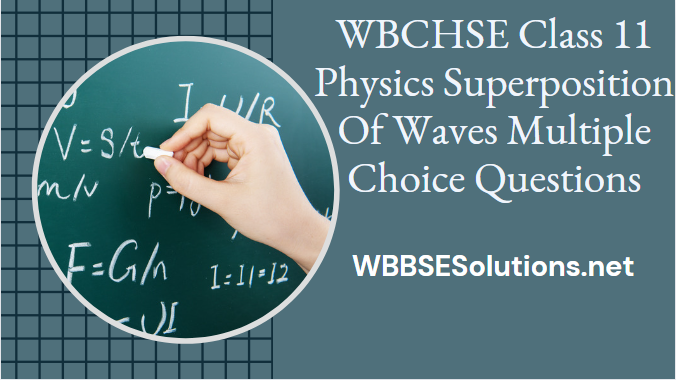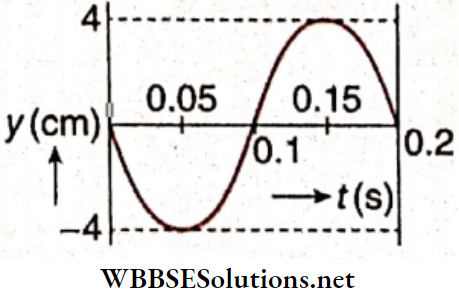Superposition Of Waves Multiple Choice Question And Answers
Question 1. A wave y= asin(ωt- kx) being superposed with another wave produces a node at x = 0. The equation of the second wave should be
- y = asin(ωt+kx)
- y = -asin(ωt+kx)
- y= asin(ωt-kx)
- y = -asin(ωt- kx)
Answer: 2. y = -asin(ωt+kx)
Question 2. At the instant when all the particles in the medium of a stationary wave are at their equilibrium positions the
- Kinetic Energy Becomes Zero
- Potential Energy Becomes Zero
- Net Energy Becomes Zero
- None Of These Becomes Zero
Answer: 2. Potential Energy Becomes Zero
Question 3. Which of the following remains constant in case of vibration of the particles in a stationary wave?
- Velocity
- Acceleration
- Amplitude
- Phase
Answer: 3. Amplitude
Question 4. When two identical sound waves superpose at a point with a phase difference of 180°,
- The point will be a node
- The intensity of the sound will increase at that point
- The point will be an antinode
- Beats will be heard
Answer: 1. The point will be a node
Question 5. The equation of a progressive wave is y = A cos (kx-ωt). This wave superposes with another wave and produces a stationary wave by creating a node at x = 0. Which of the following equations is correct for the other wave?
- Asin(kx+ωt)
- -Asin(kx-ωt)
- -Acos(kx+ωt)
- -Asin(kx-ωt)
Answer: 3. -Acos(kx+ωt)

Question 6. A fundamental tone of frequency n1 is produced when a string stretched at both ends is vibrated. The frequency of the fundamental tone changes to n2 when the tension in the string is doubled. What is the ratio of n1 and n2?
- 1: 2
- 2: 1
- 1:√2
- √2: 1
Answer: 3. 1: √2
Question 7. The waves generated due to the vibration of an air column in a pipe open at one end or a pipe open at both ends are
- Transverse progressive waves
- Transverse stationary waves
- Longitudinal progressive waves
- Longitudinal stationary waves
Answer: Longitudinal stationary waves
Question 8. When a fundamental tone is produced from a pipe of length l, open at both ends, the wavelength of the stationary wave is
- \(\frac{l}{2}\)
- l
- 2l
- 4l
Answer: 3. 2l
Question 9. If the frequency of the fundamental tone emitted from a pipe closed at one end is 200 Hz, then the frequencies of the first three overtones will be
- 400 Hz, 600 Hz, 800 Hz
- 600 Hz, 1000 Hz, 1400 Hz
- 400 Hz, 800 Hz, 1200 Hz
- 600 Hz, 800 Hz, 1000 Hz
Answer: 2. 600 Hz, 1000 Hz, 1400 Hz
Question 10. A fundamental tone is emitted from a pipe closed at one end. If the closed end is suddenly opened,
- The pitch of the tone decreases
- The intensity of the tone decreases
- The pitch of the tone increases
- The intensity of the tone increases
Answer: 3. The pitch of the tone increases
Question 11. When a fundamental tone is produced from a pipe of length l, closed at one end, the wavelength of the stationary wave is
- \(\frac{l}{2}\)
- l
- 2l
- 4l
Answer: 4. 4l
Question 12. Due to the end error in stationary waves produced in a closed or an open pipe
- Antinodes are not formed at the closed end
- Antinodes are formed inside the pipe very close to its open end.
- Nodes are formed slightly outside the open end of the pipe
- None of these
Answer: 3. Nodes are formed slightly outside the open end of the pipe
Question 13. When the temperature of the air in a closed or so open pipe increases, the frequency of stationary wave will
- Remain the same
- Increase
- Decrease
- Depending on other factors also
Answer: 2. Increase
Question 14. The frequencies of the fundamental tones in a dosed and an open, pipe are the state The talks of the lengths of the two pipes is
- 1:1
- 1:2
- 2:1
- 4:1
Answer: 2. 1:2
Question 15. While measuring the speed of sound by performing a resonance column experiment, a student gets the first resonance condition at a column length of 18 cm during winter. Repeating the same experiment during summer, he measures the column length to be x cm for the second resonance. Then,
- 18 > x
- x > 54
- 54 > x > 36
- 36 > x > 18
Answer: 2. x > 54
Question 16. A student is performing the experiment of the resonance column. The diameter of the column tube is 4cm The frequency of the turning fork is 512HZ. The air temperature is 38C in which the speed of sound is 336m/s. The zero of the meter scale coincides with the top end of the resonance column tube. When the first resonance occurs, the reading of the water level in the column is
- 14 cm
- 15.2 cm
- 16.4cm
- 17.6cm
Answer: 2. 15.2 cm
Question 17. A student is performing an experiment using a resonance column and a turning fort of frequency 244 s-1. He is told that the air in the tube has been replaced by another (assume the fear fee column remains filled with gas). If the minimum height at which resonance occurs is (0.350 ± 0.005) m, the gas in tube is (using information: √167RT = \(640 \mathrm{~J}^{1 / 2} \cdot \mathrm{mol}^{-1 / 2}; \sqrt{140 R T}=590 \mathrm{~J}^{1 / 2} \cdot \mathrm{mol}\). The molar masses M in grams are given in fee options. Take the value of \(\sqrt{\frac{10}{M}}\) for each gas as given there)
- Neon \(\left(M=20, \sqrt{\frac{10}{20}}=\frac{7}{10}\right)\)
- Nitrogen \(\left(M=28, \sqrt{\frac{10}{28}}=\frac{3}{5}\right)\)
- Oxygen \(\left(M=32, \sqrt{\frac{10}{32}}=\frac{9}{16}\right)\)
- Argon \(\left(M=36, \sqrt{\frac{10}{36}}=\frac{17}{32}\right.\)
Answer: 4. Argon \(\left(M=36, \sqrt{\frac{10}{36}}=\frac{17}{32}\right.\)
Question 18. What should be fee beat frequency so that it is not audible to the human ear?
- Greater than 10 Hz
- 10 Hz
- 5 Hz
- Less than 5 Hz
Answer: 1. Greater than 10 Hz
Question 19. If n1 and n2 are fee frequencies of two sound waves, the frequency of the beat produced due to the superposition of these waves will be
- \(n_1-n_2\)
- \(n_1+n_2\)
- \(\frac{n_1+n_2}{2}\)
- \(2\left(n_1-n_2\right)\)
Answer: 1. \(n_1-n_2\)
Question 20. Beats are not observed for light waves, because
- There is no difference in the velocities of the two light waves
- It is impossible to stabilize the frequency difference of two light waves below 10 Hz
- It is impossible to keep the intensities of two light waves equal or nearly equal
- None of these
Answer: 2. It is impossible to stabilize the frequency difference of two light waves below 10 Hz
Question 21. When two waves y1 = A sin2008πt and y2 = A sin2008πt are superposed, the number of beats produced per second is
- 0
- 1
- 4
- 8
Answer: 3. 4
Question 22. A set of 25 tuning fork is arranged in a series of decreasing frequencies such that each fork gives 3 beats with the succeeding one. The first fork is the octave of the last. Frequency of fee 10th fork is
- 120Hz
- 117Hz
- 110Hz
- 89Hz
Answer: 2. 117Hz
Question 23. The displacement of a particle in a medium at an instant due to the effect of more than one wave is
- Not dependent on the displacements due to the individual waves
- Equal to the vector sum of fee displacements due to fee individual waves
- Equal to fee displacement due to any one of the waves
- Random due to the effect of all the waves
Answer: 2. Equal to fee vector sum of fee displacements due to fee individual waves
Question 24. A sound wave of frequency 500 Hz is advancing along the positive x-axis with a speed of 300 m · s-1. The phase difference between the two points x1 and x2 is 60°. The least distance between those two points is
- 1 mm
- 1cm
- 10cm
- 1 m
Answer: 3. 10cm
Question 25. When two progressive waves y1= 4sin(2x-6t) and \(y_2=3 \sin \left(2 x-6 t-\frac{\pi}{2}\right)\) are superposed, the amplitude of the resultant wave is
- 5
- 6
- \(\frac{5}{3}\)
- \(\frac{1}{2}\)
Answer: 1. 5
Question 26. A hollow pipe of length 0.8 m is closed at one end. At its open end, a 0.5 m long uniform string is vibrating in its second harmonic and it resonates with the fundamental frequency of the pipe. If the tension in the wire is 50 N and the speed of sound is 320 m • s-1, the mass of the string is
- 5g
- 10 g
- 20 g
- 40 g
Answer: 2. 10 g
Question 27. A sound of 20dB is more intense than a sound of 10 dB by
- 100
- \(\frac{1}{10}\)
- 10
- 0.01
Answer: 3. 10
In this type of question, more than one option is correct.
Question 28. For a certain transverse standing wave on a long string, an antinode is formed at x = 0, and next to it, a node is formed at x = 0.10 m. The displacement y(t) of the string particle at x = 0 is shown.

- The transverse displacement of the particle at x = 0.05 m and t = 0.05 s is -2√2 cm
- Transverse displacement of the particle at x = 0.04 m and t = 0.025 s is -2 √2 cm
- The speed of the traveling waves that interface to produce this standing wave is 2 m • s-1
- The transverse velocity of the string particle at x = \(\frac{1}{15}\)m and t = 0.1 s is 20π cm· s-1
Answer:
1. The transverse displacement of the particle at x = 0.05 m and t = 0.05 s is -2√2 cm
3. The speed of the traveling waves that interface to produce this standing wave is 2 m • s-1
4. The transverse velocity of the string particle at x = \(\frac{1}{15}\)m and t = 0.1 s is 20π cm· s-1
Question 29. Following are equations of four waves
- \(y_1=a \sin \omega\left(t-\frac{x}{v}\right)\)
- \(y_2=a \cos \omega\left(t+\frac{x}{v}\right)\)
- \(z_1=a \sin \omega\left(t-\frac{x}{v}\right)\)
- \(z_2=a \cos \omega\left(t+\frac{x}{v}\right)\)
Which of the following statements is correct?
- On superposition of waves (1) and (2), a traveling wave having amplitude a√2 will be formed
- Superposition of waves (2) and (3) is not possible
- On superposition of (1) and (2), a stationary wave having amplitude a√2 will be formed
- On superposition of (3) and (4), a transverse stationary wave will be formed
Answer:
1. On the superposition of waves (1) and (2), a traveling wave having amplitude a√2 will be formed
4. On superposition of (3) and (4), a transverse stationary wave will be formed
Question 30. One end of a taut string of length 3m along the x-axis is fixed at x = 0. The speed of the waves in the string is 100 m · s-1. The other end of the string is vibrating in the y-direction so that stationary waves are set up in the string. Obtain the possible waveforms of this stationary wave.
- \(y(t)=A \sin \frac{\pi x}{6} \cos \frac{50 \pi t}{3}\)
- \(y(t)=A \sin \frac{\pi x}{3} \cos \frac{100 \pi t}{3}\)
- \(y(t)=A \sin \frac{5 \pi x}{6} \cos \frac{250 \pi t}{3}\)
- \(y(t)=A \sin \frac{5 \pi x}{2} \cos 250 \pi t\)
Answer:
1. \(y(t)=A \sin \frac{\pi x}{6} \cos \frac{50 \pi t}{3}\)
3. \(y(t)=A \sin \frac{5 \pi x}{6} \cos \frac{250 \pi t}{3}\)
4. \(y(t)=A \sin \frac{5 \pi x}{2} \cos 250 \pi t\)

